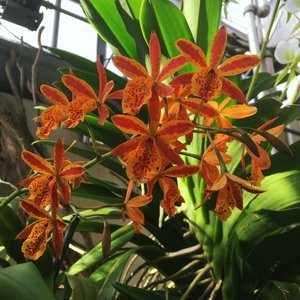Orchid Care
During a visit to the National Botanic Garden and Conservatory in Washington DC this winter, I was struck by the variety in the orchid collection.
The range of sizes, from tiny 1/2 inch blooms to 5 inch show stoppers, was really interesting. I was also impressed by the speckled varieties. It was hard not to get a little photo happy when I came upon them!
Cattlianthe Portzac
Dendrobium Shiraishii
Epicatanthe Volcano Trick "Orange Fire"
I won't claim to know much about these plants. I do know that I think they are beautiful and, that judging by the numbers you see in the home improvement stores, people are buying them and enjoying them. But, I haven't tried them before. I think I've seen too many others attempt to care for them and fail. Enter, Martha.
I called on a good friend and home gardener to share her best practices for orchid care. She keeps a large orchid collection in her dining room, and she's become her community's "orchid saver." Whenever someone "fails" at an orchid plant or gives up on it after it blooms, she takes it in and nurtures it back to health.
The plants enjoy westerly light on two window-side tables where they compliment an eclectic collection of her mother's post-impressionist and abstract paintings.
When I asked if she'd share some secrets about her orchid collection, she told me that she thought she'd just been lucky and found some good light for them. But when we sat down this month, I learned a whole lot more about orchids than I ever expected to.
The oldest plants in her collection have been with her for ten years. She bought them at a sale benefitting the library in Upper Jay, New York, near her own farm. Those plants, donated to the library by local orchid lover Ellen Metcalf, seem as happy and healthy as the ones given to her recently by friends who couldn't quite figure them out. "People give me dying orchids and I re-pot them," says Martha. She picked up a few others at home improvement stores, where she says she can find them at a huge markdown post bloom for as little as $5 a plant.
"The orchids you find at home improvement stores are often phalaenopsis. They are the most common variety, and they are the easiest to care for."
This is good news for me. It means that the less expensive plants are the right place for beginning orchid gardeners to start. However, she warns, "sometimes you'll notice that chain stores dye them with colored water to alter the flower color. When you bring them home, you'll often find that the next flowers are ivory or white colored."
"With orchids, you have to be patient," says Martha.
"Bonsai patient," I replied. But when I thought about it, I also spend inordinate amounts of time waiting and wishing for plants to bloom. I'm thinking that some of the differences in my thoughts towards them are rooted in how little orchid plants physically change between blooms.
Oncidium 'Pacific Passage' Handsome
Oncidium 'Twinkle'
Orchidaceae Tolumnia, Bulls Eye
"Orchids get some moisture from the air, that's why you'll see their roots spilling out over the tops of planters. They can also photosynthesize through their roots," says Martha.
"Which explains why you find many of them growing in clear pots." Martha's collection occupies a variety of clear plastic and glass pots and a number of ceramic vessels. "They don't like soil. They need wood chips or coconut bark." Martha swears by rePotme.com's coconut and vermiculite orchid mix.
She adds, "You can tell that a plant is doing well if there is a dark red line around the edge of the leaf."
Every ten days, Martha gives them between 1/4 and 3/4 cups of water, depending on the size of the plant. She notes that others have success giving their plants an ice cube each a day. Watering every ten days feels more convenient to her, and she worries that the ice might burn the orchids' roots. They also like to be misted, she says.
When things are going well, the orchids bloom every six months for two months at at time.
I'm thinking that the long bloom time is a payoff for the patience along the way. Martha's collection includes cream, white, pink, purple, yellow, and variegated (purple with darker purple) varieties.
Every six months, she gives them a few drops each of Orchid Love fertilizer (a kelp and "liquid fish" concoction) mixed into the water.
After blooming she cuts the stems back to within two to three inches of the soil so that nutrients are not sent back up the stem.
Cut the stem just above a node so that another stem can begin. (see photo) If the leaves collect dust they can be cleaned with a soft cloth and some gentle soapy water.
In essence, she says, "orchids need food and six months. For me, they were easy. I never expected to keep orchids as a hobby."
If you happen to receive a lovely orchid plant in the near future, perhaps for the upcoming February "holiday of love," I hope these notes will prove helpful. I certainly learned a lot from my friend. Our conversations usually center around our two young boys and their appreciation for Pokemon cards. It was a relief just to have a few moments to talk flowers with her!
As always, I appreciate your comments and questions, and I especially appreciate any suggestions you might have for future articles.
Warmly,
Update! Martha checked back in with me the following week. The first of her orchids had bloomed and now, half way through January, nearly every one of them is about to put out a shower of blossoms. She says it is the first time, in her experience, that all of her plants have bloomed at or near the same time. It is going to be a beautiful show.









